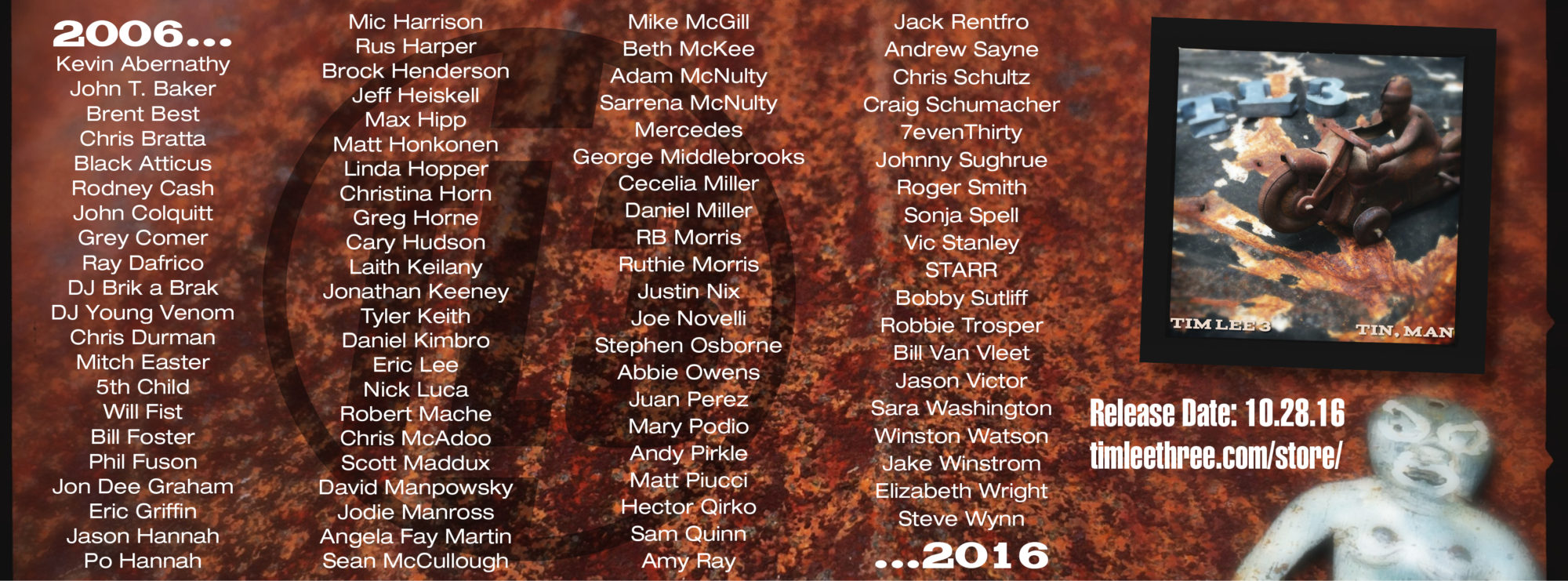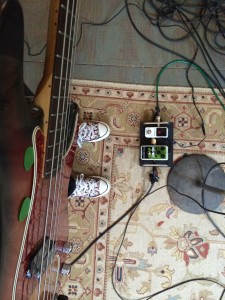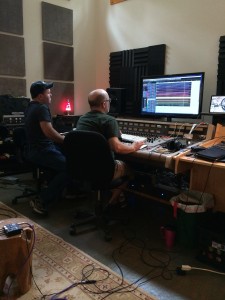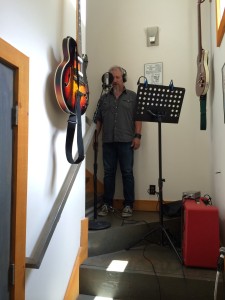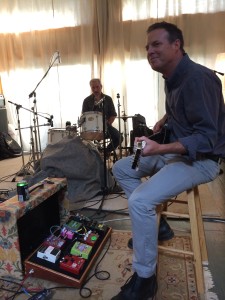(July 13, 2015) After a couple weeks, I’m back. Following last month’s whirlwind of gig activity, July is much slower, just a couple local shows.
Well, that and the recording of some new TL3 songs and the organization of a Neil Young Tribute Show that only involves some 14 people and nearly 20 songs.
Okay, maybe “slower” isn’t the right word.
For the past five Januaries, Susan and I have been involved in an annual benefit called Waynestock, a multi-day show featuring a wide variety of area bands and artists. The first one was thrown together quickly to raise funds for the family of our friend, Knoxville music writer Wayne Bledsoe after his 23-year-old son Andrew died from a suspected heart defect.
It took legs pretty quickly, and every year Waynestock benefits a different deserving family or organization.
During the last three, our band has hosted the finale set involving several artists from around town. This past January’s was a Young tribute, which went over well, so our friends out at the Shed in Maryville asked us to reprise it on their stage on July 25. Some of the folks who took part in the first one are not available this time around, and some who weren’t able to participate back in January are free this time. So there’s plenty to work on, personnel-wise, plus we’re adding some more songs.
Yeah, we have a tendency to take on a lot of stuff.
We had our first rehearsal last Tuesday, and it made for a good start. I’ll write more about that later. There’s much more preparation to be done with a whole bunch of good folks.
For now, I’ll talk about last weekend, and how we recorded five new songs. Sure, we just put out 33 1/3 four months ago, but I really like to move forward at all times.
Like a shark: slow down, I’ll end up dead. That’s my philosophy.
That’s how we got started on what might be our next album so soon after the last one. We’ve got some cool plans for these tracks in the meantime. More on that later too.
Friday night, Susan and I went over to our pal John Baker’s Arbor Studio, got our gear set up and got some basic sounds. Chris was out of town, so John hit the drums and we sorted those out as well.
John was one of the first people I met when we moved to Knoxville 15 years ago, and we’ve worked on various projects off and on for years. He’s recently built a really cool studio on the property behind his house, and this was our first recording experience there. Another friend, Gray Comer, has been assisting John on projects, engineering and helping out with various tasks. Gray’s former band, the Westside Daredevils, shared our rehearsal space for several years, so he’s another longtime buddy.
The plan was to have things set up and ready to go for when we showed up on Saturday at 11 a.m. It didn’t take long to get it together, so Susan and I hung around to listen to records and visit with John and Gray before heading home via stops at Hops & Hollers for a beer and great food from the Retro Taco food truck (the monster nachos rule) and Lost & Found Records to wish Nathan Moses a happy birthday.
Come Saturday morning, we met Chris at the Arbor (following a swing by K Brew for killer coffee … Knoxville is blessed with an abundance of both good coffee shops and record stores, not a bad combination at all). He took a few moments to tweak the drums to his liking and get a headphone mix that worked. And in no time, we were tracking.
There are many ways to record a song, and I’ve worked with most of the standard methods (and probably a few non-standard approaches).
In the earliest days of music recording, bands played live with the singer, the performance captured by a minimum number of microphones and mixed on the fly. The sax player not loud enough? Play it again with his horn closer to the mic. It was all pretty simple.
As time passed and technology allowed for multiple instrumental tracks and extensive overdubbing, other approaches surfaced. A lot of times, artists just try to get a solid drum track and then add all the other instruments one at a time. Doing that allows for more control over individual sounds and performances. Some folks still record completely live. Some do everything on a computer, piecing bits together without actually “playing” anything.
And in between, there are an endless number of ways to do it, all of them equally legitimate. Since the beginning of the TL3, we’ve always opted to get a “basic track,” a recording of the song with complete drum kit, bass, and rhythm guitar performances. From there, we add vocals, percussion (shakers, tambourines, etc.), and extraneous guitar parts or keyboards. This gives us a recording that has the chemistry of the trio playing together, but allows us the space to expound on the song in the studio.
To my mind, playing live and making records are two different things. Sure, they have some things in common, but they are not the same animal. Other people see it differently. Our methods work for us, so we generally stick with them.
It’s funny; I was talking to a young singer-songwriter and his band from around here a few years ago. They told me how they built their tracks one instrument at a time, and I told them about our approach. I left the room, but returned to get my jacket just in time to hear the omnipotent youngster opine that I must be crazy to think you could record a band “live” in the studio.
I laughed. I wonder how he thinks his favorite ’60s and ’70s recordings were made.
Meanwhile, back at the Arbor, we got settled in and John hit the “Record” button. We started with a song called “Superstition,” that we’ve been playing since our record release show in March. We always warm up with it at practice too, so we can pretty much play the song in our sleep. We got a good version on the first attempt, but as is usually the case, there were a few technical adjustments that needed to be made. The second take was also good, and there were no glitches, so we had our first basic track in the can before noon.
From there, we got on a roll and got the other four basics nailed in one or two takes apiece. Without rushing ourselves, we were done with that process within a couple hours. We had played the songs numerous times, either in rehearsals or on the stage. “Fall From Grace” I’ve mentioned here. “No Rest” was considered for 33 1/3, as was “See the Light,” but we never got around to recording them. “Kryptonite” is pretty new. We played it at our record release show, but haven’t played it live since, opting to tweak on the arrangement in the meantime.
The Arbor’s main room is a very comfortable place to record. It’s an open control room design, meaning the recording console is in the room with the players. We’re used to that from all the sessions we’ve done at Craig Schumacher’s Wave Lab Studio in Tucson, where a big chunk of our catalog was recorded. We felt at home, which is what allowed us to breeze through basic tracking so quickly.
Following a short break, we discussed which path we wanted to take as we moved forward. Usually, the first thing we overdub is percussion, which is what most folks do last, almost as an afterthought. I like letting the texture of the shakers and tambourines and such help dictate where you go with the other instruments.
For these songs, we plan to have our friend Beth McKee add keyboards when she’s in town next week. Beth and I went to grade school and junior high together until my family moved away after 8th grade. We’ve reconnected in recent years, and she’s a badass piano player/singer/songwriter with musical roots in Mississippi, New Orleans, and Austin.
Check out her records, especially her latest, “Sugarcane Revival.” I got to play guitar on a couple songs on it.
Beth’s husband, Juan Perez, is a killer drummer/percussionist with a lengthy resume, so we’re hoping to have him play some percussion when we’re in the studio with her.
Since we weren’t starting with percussion, we opted to do vocals first. A lot of artists choose to record the singing after all the other instruments are recorded, but doing them earlier gives you the option to build the overdubs around the vocals (obviously, the most important part of non-instrumental music) instead of the other way around.
Over the years, Susan has become a very strong, confident vocalist. She sang the lead vocals on “Kryptonite” and “See the Light” in one or two takes each, with just a little fixing of phrases here and there.
I’ve been singing on records for over 30 years now, and I’m still not that confident in my abilities on that level. Playing guitar is no problem. I’m completely sure about myself in that capacity, but singing is still kind of problematic. I just don’t feel like I have a strong voice, so I make it a point to defer to Susan and in this case, John and Gray, as to when I’ve gotten a decent vocal performance.
Still, I got through “Superstition,” “No Rest,” and “Fall From Grace” with minimal trouble. Of course, Susan killed with her backing vocals.
Gray had to bug out of the dugout in the late afternoon, so we took a break. John walked to his house for lunch, while Susan and I headed to the hacienda to feed the dogs and grab a snack. Chris hit the road for a gig that night with his other band, the Knox County Jug Stompers.
With the exception of a couple songs here and there, all the TL3 songs have been recorded out of town. It’s a luxury to leave your home base to record, because you leave behind the mundane tasks (such as feeding your pets) and live for however many days in the cocoon of recording. With fewer distractions, you can get more done in less time.
Still, we had no trouble maintaining our momentum when Susan, John, and I reconvened around 5. We had a couple more backing vocal tracks to do, which went quickly, and we went straight into adding guitars.
I’d talked to Kevin Abernathy about dropping by to add a track of guitar to “Fall From Grace,” since he’s played it with us on several occasions live. Despite his own busy day, he came by and knocked out a part in short order. Kevin hung out for a few minutes, but had somewhere to be, so it came time for me to do my thing with the six string (to “make that twine whine,” as Bo Ramsey would say).
<Geek sidebar: For this session, I played my red Telecaster (color is important) through my pedalboard split into my red Carr Hammerhead and John’s Orange Tiny Terror with a 1-12 cabinet. I switched to my single-pickup Les Paul Jr. for several of the overdubs. Pedals I remember using include an Xotic EP Boost (which stayed on at 9 o’clock the whole time), BBE Two-Timer Delay (on slap back for all the basics, longer delay for solos), Malekko Reverb (I forget the name, but it’s pink and sparkly) on a couple songs, the Janglebox 2 clone that my pal George Middlebrooks built, and a T. Rex Tremster. I think I used the Bass Big Muff and/or the Barber Tone Pump on a couple solos. The only variation from this setup was the use of John’s Tokai Strat through his Leslie cabinet for a couple parts. >
I’m not the world’s greatest guitar player by any stretch of the imagination, but I’ve been doing it a long time and I really enjoy it, so it’s kind of effortless at this point. That said, I don’t really remember much of the specifics of recording guitars, except that Gray came back by at some point and we added stuff to all the tracks. I’ll be getting rough mixes soon, so I can remind myself exactly what I did.
All of the above made for a long day, but a very satisfying one.
It takes a lot of energy and concentration to get that much work done in a relatively short period of time, but it is a lot of fun. As I’ve pointed out so many times before, it’s more about the people you’re dealing with than anything else. All the cool recording gear in the world doesn’t do a thing on its own. For us, anyway, the whole process is greatly aided by a good vibe and atmosphere. John and Gray and the Arbor were all great in that regard.
Look for further reports on this project in upcoming blogs. In the meantime, keep it between the ditches. We’ve got to work on a batch of Neil Young songs, prepare for some Bark shows, and keep moving forward.
Talk to you soon.
— TL
